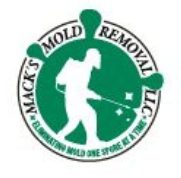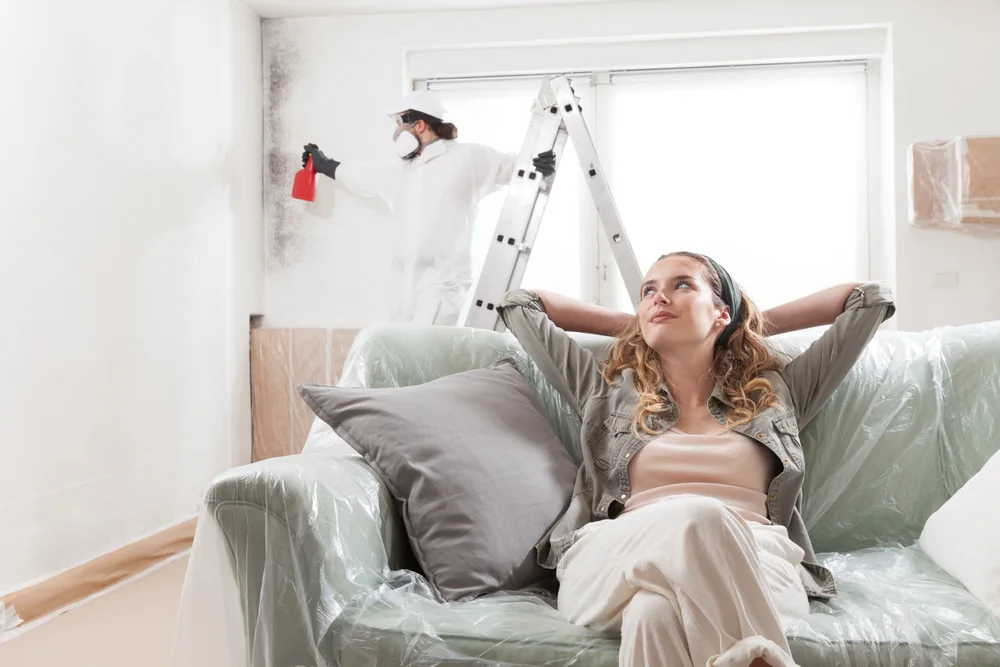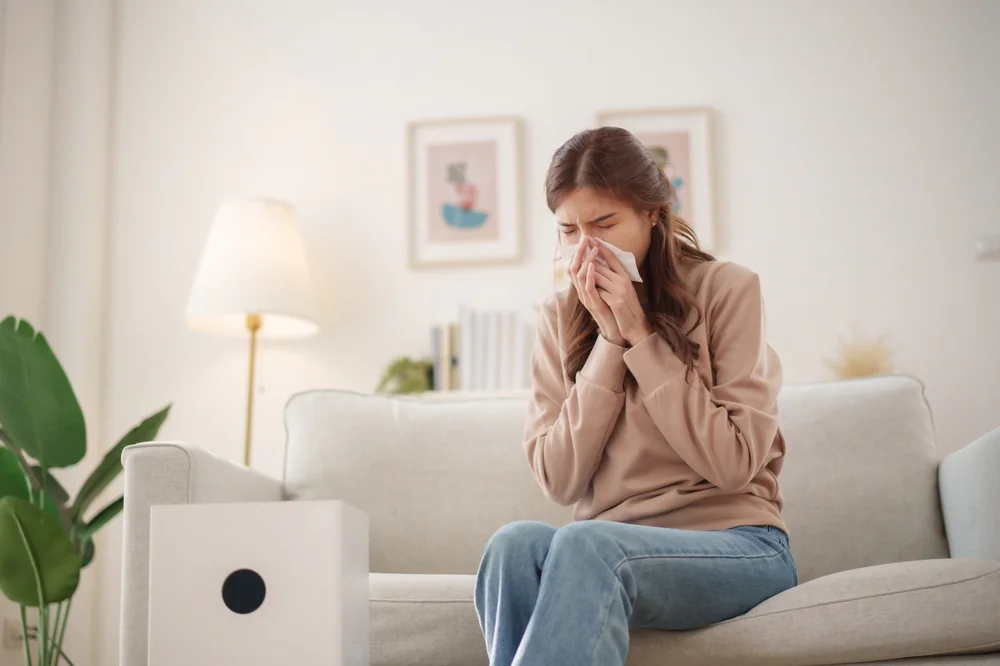Summary:
Why Water Damage Creates Perfect Mold Conditions
Mold doesn’t need much to thrive—just moisture, organic material, and time. When water damage occurs in your Bucks County home, you’ve essentially created a mold paradise.
The science is straightforward but concerning. Mold spores are everywhere, floating invisibly through your home’s air. Under normal conditions, they’re harmless. But when they land on wet surfaces, they transform from dormant spores into active colonies within hours.
Pennsylvania’s humid climate makes this process even faster. The combination of moisture from water damage and our region’s natural humidity creates an environment where mold doesn’t just survive—it multiplies rapidly, often doubling its coverage every 24 to 48 hours.
The 24-48 Hour Critical Window
Time is your enemy when it comes to mold prevention after water damage. We consistently emphasize one crucial timeline: you have 24 to 48 hours to dry wet materials before mold growth becomes inevitable.
This isn’t arbitrary—it’s based on decades of research into mold biology. During the first 24 hours, mold spores are still settling and beginning to germinate. They’re vulnerable during this stage, and thorough drying can prevent establishment. After 48 hours, established colonies begin releasing new spores, creating a cycle that becomes increasingly difficult to break.
The challenge in Bucks County homes is that water damage often affects areas you can’t easily access or monitor. Water travels through wall cavities, soaks into subflooring, and saturates insulation—all prime mold real estate that remains wet long after visible surfaces appear dry.
Consider what happens during a typical basement flood. You pump out the standing water, run fans on the visible surfaces, and assume you’ve handled the problem. Meanwhile, moisture has wicked up into drywall, soaked wooden studs, and saturated the vapor barrier behind your finished walls. These areas can remain damp for weeks, providing the perfect environment for extensive mold growth.
The economic implications are staggering. What could be prevented with immediate, thorough drying often becomes a remediation project costing thousands. Insurance claims data shows that mold damage discovered weeks after water damage typically costs 300-500% more to address than immediate prevention efforts.
Temperature plays a crucial role in this timeline. Mold grows faster in warm conditions, and heated homes during Pennsylvania winters can accelerate growth rates. Conversely, proper climate control—maintaining temperatures below 77°F and humidity below 50%—can slow mold development and extend your intervention window.
Hidden Moisture: Where Mold Develops Undetected
The most dangerous mold growth happens where you can’t see it. Water has an uncanny ability to find hidden pathways through your home’s structure, creating mold colonies that can grow for months before detection.
Wall cavities are prime real estate for hidden mold. When exterior walls get wet—whether from roof leaks, plumbing failures, or flooding—moisture can travel horizontally and vertically through your home’s framing. The space between your drywall and exterior sheathing creates a perfect microclimate: dark, humid, and undisturbed. Mold colonies in these areas can spread across entire wall sections before you notice the first signs of discoloration on interior surfaces.
Subfloor areas present another critical concern. Hardwood floors, laminate, and tile can look perfectly normal while the subflooring underneath harbors extensive mold growth. This is particularly common in Bucks County homes with basement moisture issues or first-floor plumbing leaks. The mold grows on the wooden subfloor and floor joists, often affecting structural integrity before causing visible problems above.
HVAC systems become mold distribution networks when moisture enters ductwork. A single leak in your air conditioning system’s condensate line can introduce moisture throughout your entire duct system. As your HVAC runs, it spreads mold spores to every room in your house. The insulation around ducts provides organic material for mold growth, while the temperature variations create condensation that keeps the growth cycle active.
Crawl spaces and attics often harbor the most extensive hidden mold growth. These areas typically have poor ventilation, temperature extremes, and multiple moisture sources. In crawl spaces, ground moisture combines with poor air circulation to create consistently humid conditions. Attics face temperature swings that create condensation on roof decking and insulation.
The challenge with hidden mold is that by the time you notice symptoms—musty odors, unexplained allergies, or visible staining—the problem has often spread far beyond the original moisture source. We use moisture meters, infrared cameras, and air sampling to detect these hidden colonies before they become major health and financial burdens.
Want live answers?
Connect with a Mack's Mold Removal expert for fast, friendly support.
Recognizing Early Warning Signs of Mold Growth
Your senses are often the first line of defense against hidden mold growth. Learning to recognize the subtle signs can help you catch problems before they become major health hazards or expensive remediation projects.
The most reliable indicator is smell. Mold produces volatile organic compounds that create distinctive musty, earthy odors. These aren’t pleasant “basement” smells—they’re sharp, persistent odors that seem to worsen in humid weather or when your HVAC system runs. If you notice these smells in specific areas of your home, especially after recent water damage, take them seriously.
Visual cues extend beyond obvious black spots on walls. Look for subtle discoloration, paint that appears to bubble or peel without explanation, and wallpaper that’s lifting at the edges. Water stains that seem to grow or change color over time often indicate active mold growth behind the surface.
Health Symptoms That Signal Mold Exposure
Your body often detects mold exposure before your eyes do. Understanding these health signals can help you identify mold problems early, potentially preventing serious respiratory issues and long-term health complications.
Respiratory symptoms are typically the first indicators of mold exposure. You might notice increased coughing, especially at night or when you’re at home. Sneezing fits that seem unrelated to seasonal allergies, persistent nasal congestion, and throat irritation that doesn’t respond to typical remedies all suggest possible mold exposure. These symptoms often improve when you leave your home and worsen when you return.
Eye and skin reactions provide additional clues. Itchy, watery eyes that persist despite allergy medications, skin rashes or irritation without obvious cause, and general fatigue that seems worse at home can all indicate mold exposure. Children and elderly family members often show these symptoms first, as their immune systems are more sensitive to mold toxins.
The timing of symptoms matters significantly. If multiple family members develop similar respiratory issues around the same time, especially following water damage, mold exposure should be strongly considered. Unlike viral infections, mold-related symptoms tend to persist and worsen over time rather than resolving naturally.
Headaches represent another common but often overlooked symptom of mold exposure. These aren’t typical tension headaches—they’re often described as persistent, dull aches that seem worse in certain areas of the home. Some people report feeling mentally foggy or having difficulty concentrating when exposed to mold toxins for extended periods.
Sleep disruption frequently accompanies mold exposure. You might find yourself waking up congested, coughing during the night, or feeling unrested despite adequate sleep. This happens because mold spores and toxins are often more concentrated in bedrooms, where poor ventilation and fabric surfaces create ideal conditions for accumulation.
It’s crucial to understand that mold sensitivity varies dramatically between individuals. Some family members might experience severe symptoms while others notice nothing. This doesn’t mean the mold isn’t dangerous—it means some people are more sensitive to its effects. Children, elderly individuals, and anyone with compromised immune systems face the highest risks from mold exposure.
Physical Signs in Your Home's Structure
Beyond health symptoms, your home itself provides clear warnings about mold growth. Learning to read these structural signs can help you identify problems before they require extensive mold remediation.
Paint and wallpaper changes often signal moisture and mold issues. Paint that bubbles, cracks, or peels without obvious cause typically indicates moisture behind the surface. This is particularly concerning when it occurs on interior walls, as it suggests water intrusion from plumbing leaks, roof problems, or exterior moisture penetration. Wallpaper that lifts at seams or develops brown or yellow stains often conceals mold growth on the wall surface underneath.
Flooring changes provide critical clues about subfloor moisture and potential mold growth. Hardwood floors that develop soft spots, warping, or unexplained discoloration often indicate moisture problems below the surface. Laminate flooring that separates at joints or develops a spongy feel underfoot suggests subfloor moisture that creates ideal mold conditions. Carpeting that develops musty odors, feels damp, or shows staining around edges typically harbors mold growth in the padding or subfloor.
Ceiling stains deserve immediate attention, especially if they appear to grow or change color over time. Active roof leaks create obvious water stains, but more dangerous are the subtle discolorations that suggest chronic moisture problems. These often indicate ongoing leaks that create perfect conditions for extensive mold growth in attic spaces and wall cavities.
Window and door frame issues frequently signal moisture problems that lead to mold growth. Condensation that persists on windows, water stains around window frames, and doors that stick or warp without explanation all suggest humidity problems that promote mold development. Pay particular attention to basement windows and doors, where ground moisture creates consistently humid conditions.
HVAC-related signs require immediate investigation. Musty odors when your system starts, visible mold around vents or air returns, and unexplained increases in allergy symptoms when heating or cooling runs all suggest mold contamination in your ductwork. This is particularly dangerous because your HVAC system can distribute mold spores throughout your entire home.
Basement and crawl space indicators include efflorescence (white, chalky deposits on masonry), rust stains on metal components, and wood that feels soft or spongy. These signs indicate chronic moisture problems that create extensive mold growth in areas you rarely inspect. The danger is that these spaces often connect to your home’s living areas through shared air systems and structural connections.
When Professional Mold Remediation Becomes Necessary
Knowing when to call professionals can mean the difference between a manageable problem and a health crisis. While small, surface-level mold issues might be handled with proper precautions, extensive growth requires professional expertise and equipment.
The scope of contamination determines your approach. Professional mold remediation becomes necessary when mold covers more than 10 square feet, affects multiple rooms, or involves HVAC systems. Hidden mold behind walls, under flooring, or in structural areas always requires professional assessment and remediation.
We bring specialized equipment, containment procedures, and expertise that prevent cross-contamination during cleanup. We understand how to safely remove contaminated materials, properly clean affected surfaces, and implement moisture control measures that prevent regrowth. Most importantly, we can identify and address the underlying moisture sources that caused the problem initially.
For Bucks County homeowners dealing with mold after water damage, our professional remediation protects both your family’s health and your property investment. We provide comprehensive assessment, safe remediation, and long-term prevention strategies that address the root causes of mold growth, not just the visible symptoms.




